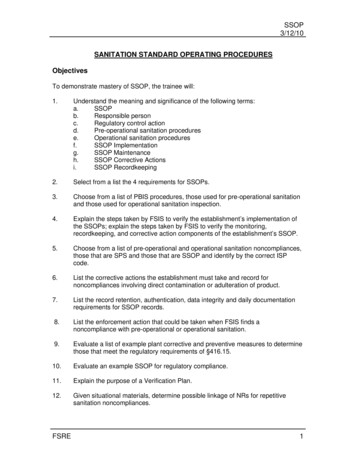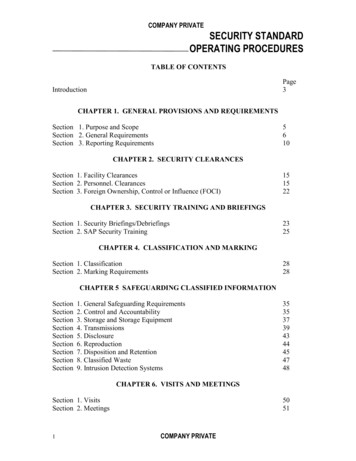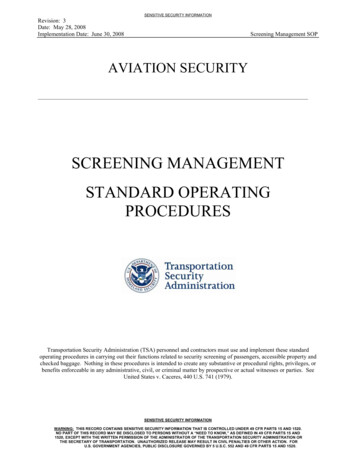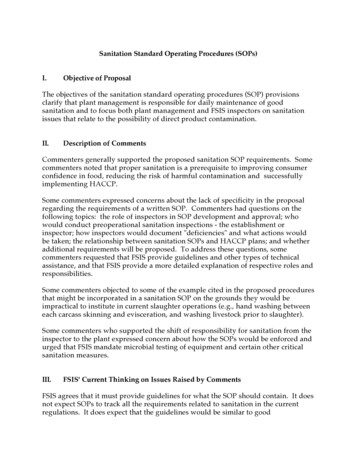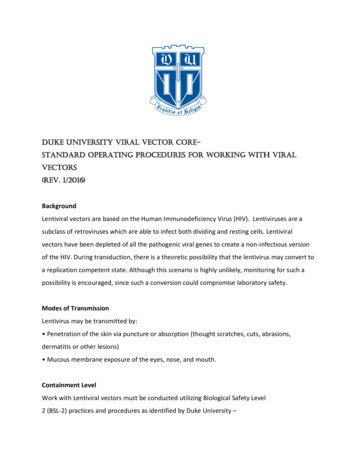
Transcription
Duke University Viral Vector CoreStandard Operating Procedures for working with ViralVectors(Rev. 1/2016)BackgroundLentiviral vectors are based on the Human Immunodeficiency Virus (HIV). Lentiviruses are asubclass of retroviruses which are able to infect both dividing and resting cells. Lentiviralvectors have been depleted of all the pathogenic viral genes to create a non-infectious versionof the HIV. During transduction, there is a theoretic possibility that the lentivirus may convert toa replication competent state. Although this scenario is highly unlikely, monitoring for such apossibility is encouraged, since such a conversion could compromise laboratory safety.Modes of TransmissionLentivirus may be transmitted by: Penetration of the skin via puncture or absorption (thought scratches, cuts, abrasions,dermatitis or other lesions) Mucous membrane exposure of the eyes, nose, and mouth.Containment LevelWork with Lentiviral vectors must be conducted utilizing Biological Safety Level2 (BSL-2) practices and procedures as identified by Duke University –
Institutional Biological Safety Committee (IBC).ApprovalDuke Viral Vector Core approved by the Duke IBC with the protocol #11-0014-03 to generateRabies virus (RV)-based system. Duke Viral Vector Core approved by the Duke IBC with theprotocol #10-6147-01 to generate Lentiviral and Adeno-Associated vector-systems.Facility ConsiderationsThe Principal Investigator of the Viral Vector Core must designate a laboratory that fulfills thefacility requirements as outline the CDC/NIH publications Biosafety in Microbiologicaland Biomedical Laboratories for Biological Safety Level 2 laboratories.Engineering ControlsThe following safety equipment MUST be used when working with Lentiviral vectors: Certified Class II Biological Safety Cabinets Sealed centrifuge rotors and/or safety cups Vacuum lines equipped with an in-line HEPA filter as well as a primary and secondary vacuumflash containing a 10% bleach solution.Administrative ControlsWork with Lentiviral vectors carry out by trained personnel who directed by a competentscientist (the PI). Access to the laboratory is limited when the agent is in use. The laboratory isposted with Duke University Biohazard signage. The Standard Operating Procedures (SOP) forthe planned procedures must be written and shall be present in the laboratory at all times. Allstaff involved with the handling and administration of adenoviral vectors must receiveBiosafety training that covers safety procedures. It is the Principal Investigator's responsibilityto identify the staff requiring this training, and to call the Biosafety office to schedule a trainingsession.
Personal Protective EquipmentThe following personal protective equipment MUST be worn when working withLentiviral vectors: Gloves (consider double-gloving depending on the procedures being performed) Lab Coat Goggles Face shieldSpecial Handling Procedures1. Cells exposed to lentiviral vectors may not be removed from the laboratory forexperimental purposes unless inactivated by approved procedures.2. If you need to aerate cultures, it must be done slowly and in a manner thatminimizes the potential for aerosol creation. This action must be carried out in aclass II biological safety cabinet.3. When pouring and pipetting samples, it must be done gently and slowly andmust be carried out in a class II biological safety cabinet.4. Extra precautions must be taken when using sharps. Appropriate substitutesfor sharp items must be used whenever they are available. No sharps (includingneedles and Pasteur pipettes) may be used for working with Lentivirus-infectedcell cultures nor when harvesting virus pellets. Use plastic aspiration pipettesinstead of glass Pasteur pipettes.5. For Aspiration- Use a plastic vacuum flask with a second vacuum flaskconnected to it as a backup, with non-collapsible tubing capable of withstandingdisinfection. To the second vacuum flask attach a hydrophobic and a HEPA filter(or combination filter) to ensure that nothing is sucked into the house vacuumsystem. These 3 items must be attached in series from the vacuum source in thehood or a vacuum pumpDecontamination/Clean-Up Procedures
All materials that have come into contact with Lentiviral vectors should bedisinfected using a 1:10 bleach solution before disposal. Additionally, all worksurfaces must be disinfected with a 1:10 solution of bleach once work iscompleted and at the end of the work day. (Note: A 15-minute contact time isrequired for decontamination)Waste Disposal Procedures1. Non-Sharp Waste- All cultures, stocks, and cell culture materials must bedisinfected and autoclaved prior to being disposed of into a double red bag-linedbiohazard box.2. Sharps Waste-All needles, syringes, razors, scalpels, Pasteur pipettes andpipette tips must be disposed of in an approved, puncture resistant sharpscontainer. Sharps containers must not be filled up more than 2/3 of their capacity.Injury/Exposure Incident Procedures1. Eye or Mucous Membrane Exposure from Splash or Aerosols- rinse aminimum of 15 minutes using eye wash and report the incident to your supervisorimmediately.2. Skin Contamination-Wash affected areas with soap and water for 15 minutesand report the incident to your supervisor immediately.3. Needlestick and/or Sharps Exposure- Wash affected areas with soap andwater for 15 minutes. Immediately notify your supervisor. He/she will completethe Post-Exposure Incident Report and submit it to the Department ofEnvironmental Health and Safety within 24 hours of the exposure. ContactUniversity Police at 8-2323 to arrange for appropriate medical attention.Spill Response ProceduresThe following steps must be taken when cleaning up a spill:1. Stop, notify others and isolate the area!2. Put on appropriate PPE (lab coat, gloves, eye and face protection).
3. Remove glass/lumps with forceps or scoop if applicable and place into a rigid,puncture resistant container.4. Small spills-Place paper towels soaked in bleach directly on the spill and letsoak for 20 minutes.5. Wipe up area and discard towels in biohazard waste container.6. Continue wiping area with paper towels soaked in bleach until the spill area iscompletely cleaned.7. Discard all materials in biohazard waste container.8. Wash hands thoroughly.ReferencesBiological Safety Principles and Practices, 3rd edition, 2000. ASM Press. Editedby Diane O. Fleming, Ph.D, and Debra Hunt, Dr.P.H.Biosafety in Microbiology and Biomedical Laboratories, 4th edition, May 1999.Centers for Disease Control. dian Laboratory Centre for Disease Control Material Safety Data /index.htmlGuidelines for Research Involving Recombinant DNA Molecules, May 1998.National Institutes of Health. www.nih.gov/od/orda/guidelines.pdf
Waste Disposal Procedures 1. Non-Sharp Waste- All cultures, stocks, and cell culture materials must be disinfected and autoclaved prior to being disposed of into a double red bag-lined biohazard box. 2. Sharps Waste-All needles, syringes, razors, scalpels, Pasteur pipettes and pipette tips must be disposed of in an approved, puncture resistant .








